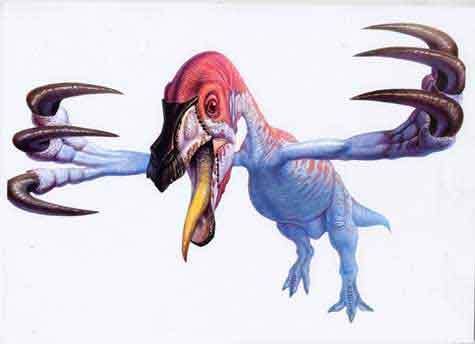Post by Barry the Baryonyx on Jul 6, 2007 14:59:43 GMT -5
Deinocheirus

Image taken from the site www.prehistoria.piwko.pl/gal_theropoda.htm
No copyright was pointed at this site
Deinocheirus (dy-no-KY-rus, Greek: 'terrible hand') was a theropod dinosaur which lived in what is now southern Mongolia, during the Late Cretaceous Period. The only known fossil remains are a single pair of massive, eight-foot-long (2.4 m) forelimbs, with 10-inch long claws and the remains of some ribs and vertebrae. Deinocheirus was named by Halszka Osmólska and Ewa Roniewicz in 1970. The type species and only named species is D. mirificus (Latin: 'unusual', 'peculiar'). Replicas of the fossilized 'arms' are currently on display at the Paleontological Museum of the University of Oslo, Norway, the American Museum of Natural History, New York and the Natural History Museum, London.
Classification
Deinocheiridae. The family Deinocheiridae was initially placed in the infraorder Carnosauria, owing to the "gigantic size and thick-walled limb bones" but Osmólska and Roniewicz also speculated that it possibly "constitutes a link between Carnosauria and Coelurosauria". Within Carnosauria, the family Deinocheiridae was tentatively assigned to the superfamily Megalosauroidea, basically because it was obviously not a tyrannosauroid (tyrannosaurids having greatly reduced forelimbs). Deinocheirus is now considered by most paleontologists to be an ornithomimosaur, as the structure of its arms is similar to other dinosaurs of this group. This would make Deinocheirus by far the largest ornithomimosaur, at approximately 23-40 ft (7-12 m) long and weighing roughly 9000 kg. Makovicky et al pointed out that if Deinocheirus is an ornithomimosaur, it is a fairly primitive one, since it lacks some of the features typically seen in ornithomimosaurs. Kobayashi and Barsbold added Deinocheirus to several recent cladistic analyses of theropods and were unable to resolve its exact relationships but noted some support for it as a possible ornithomimosaur.
Biology
Early work generally envisioned Deinocheirus as a carnivore that used its long forelimbs "in tearing dead or weakly agile prey asunder" (Osmólska & Roniewicz 1970: 15). Lambert embellished this view, describing the clawed hands of Deinocheirus as "horrifying weapons for attacking dinosaurs of almost any size ... capable of ripping open a sauropod's soft underbelly". Paul disagreed, writing that the claws are too blunt for killing but would have been good defensive weapons. Rozhdestvensky compared the forelimbs of Deinocheirus to sloths, leading him to hypothesize that Deinocheirus was a specialized climbing dinosaur, that fed on fruits and leaves and perhaps also eggs and any small animals found in trees. Rozhdestvensky imagined Deinocheirus with the trunk and hind limbs no longer than the fore limbs but there is no hard evidence for this and the climbing hypothesis has not received much support from other scientists.
© 2007 Answers Corporation


 Is it just us?
Is it just us?